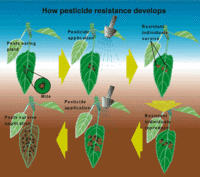-
Uncovering drug resistance mechanism to help development of antibiotic drug candidates
The use of antibiotics is often considered among the most important advances in the treatment of human disease. Unfortunately, though, bacteria are finding ways to make a comeback. More than two million people in the United States come down with antibiotic-resistant infections annually, and at least 23,000 die because their treatment cannot stop the infection. A new study has uncovered a mechanism of drug resistance. This knowledge could have a major impact on the development of a pair of highly potent new antibiotic drug candidates.
-
-
Superbugs presence increases during annual pilgrimage to India’s sacred sites

The spread of antibiotic-resistance to one of the most pristine locations in Asia is linked to the annual human pilgrimages to the region, new research has shown. The researchers have found that in May and June, when hundreds of thousands of visitors travel to Rishikesh and Haridwar to visit sacred sites, levels of resistance genes that lead to “superbugs” were found to be about sixty times greater than other times of the year. They argue that preventing the spread of resistance genes that promote life-threating bacteria could be achieved by improving waste management at key pilgrimage sites.
-
-
Solution to drug resistance problem receives U.S. patent
Before the development of penicillin, people dropped like flies in response to minor infections. Even pimples could grow to boils that killed. One of the main killers prior to the discovery of antibiotics was tuberculosis. The deadly infectious disease that typically affects the lungs has returned – and has developed a resistance to the majority of antibiotics that would otherwise kill the tuberculosis bacteria. A Danish chemistry researcher has taken out a patent for a drug that can make previously multidrug-resistant bacteria once again responsive to antibiotics.
-
-
Gaining better understanding of tularemia, aka “rabbit fever”
Tularemia, aka “rabbit fever,” is endemic in the northeastern United States, and is considered to be a significant risk to biosecurity — much like anthrax or smallpox — because it has already been weaponized in various regions of the world. Despite its importance for both public health and biodefense, F. tularensis pathogenesis is not entirely understood, nor is it fully understood how the organism persists in the environment.
-
-
Resistance shapes the discovery of new insecticides

Recent news around the world has focused on the dangers of antibiotic resistance. – and the CDC estimates over two-million illnesses and 23,000 deaths occurred in 2013 as a result of antibiotic resistance in bacteria and fungus. But what of another type of resistance which can also have a huge impact on the population: that to insecticides? Livestock, for example, are affected by buffalo flies; farmers and customers are familiar with the total devastation caused by fruit flies; malaria mosquitoes and bed bugs are becoming more resistant to existing chemicals. Even our pets are affected: fleas and ticks are continuing their march, leading to a need for newer, often more expensive synthetic chemistries. The price of insecticide resistance — in the form of R&D costs for new compounds — is passed from chemical companies, to farmers, to consumers.
-
-
W.Va. spill leads lawmakers, industry to look at reforming toxic substances law
The government was slow to respond to the 9 January 2014 massive chemical spill in West Virginia because the law governing such response, the 1976 Toxic Substances Control Act (TSCA), limits regulatory agencies’ authority to investigate such spills.Under TSCA, the EPA must first prove that a chemical poses an unreasonable risk to health or the environment before it can require the needed testing that would show a potential risk. One observer called this a Catch-22, telling a congressional panel that “This is like requiring a doctor to prove that a patient has cancer before being able to order a biopsy.”
-
-
Floods caused lead poisoning in U.K. cattle
Massive floods in England and Wales have forced thousands to evacuate their homes and destroyed railways and roads. Scientists say the U.K. floods of recent years carry yet another danger with them: lead poisoning. Silage cut from fields soon after they were inundated in the 2012 floods and then fed to cattle raised the lead levels in the animals, killing some of them. Blood samples taken from cattle showed that all of them had lead levels beyond the safe limit for human consumption. An autopsy carried out on one of the casualty animals found lead concentrations 79 times the safe level in its kidney. The contaminated material is thought to originate from historical metal mining in the area. Scientists say a number of river catchments throughout England and Wales face a similar risk.
-
-
North Carolina brain surgery patients exposed to deadly disease
Officials at a North Carolina hospital last Tuesday notified eighteen patients that they might have been exposed to Creutzfeldt-Jakob disease (CJD), a degenerative brain disease which is always fatal and which makes those infected exhibit symptoms of dementia before they die. The eighteen patients had brain surgery performed on them since 18 January. A patient operated on that that day was subsequently tested positive for the disease. The hospital said that the surgical instruments used on the patient with CJD were sterilized, but were “not subjected to enhanced sterilization procedures.’
-
-
Real-time livestock disease situational awareness
Veterinarians are the U.A. first responders for animal health, acting as the primary line of defense against animal disease outbreaks and are essential to the protection of our animal industries and economy. Researchers at the National Center for Foreign Animal and Zoonotic Disease Defense (FAZD Center) are working with veterinarians, federal and state animal health officials, and industry partners to improve real-time situational awareness of animal diseases.
-
-
Security of dirty bomb materials in U.S. inadequate: experts
There are more than 5,000 medical and research devices in the United States containing high-activity radiation sources, including 700 with category-1 sources. Category-1 radiation material could be used by terrorists in dirty bombs. The security measures developed by the industry were written with accident prevention in mind, not in order to thwart a deliberate, forcible effort by terrorists or criminals to gain control of the toxic material. In addition, radioactive materials were considered to be “self-protecting,” because it was assumed that the powerful radiation would deter anyone thinking of tampering with these devices. Terrorist bomb-makers, however, showed themselves to be more technologically-savvy than earlier thought, and, in any event, suicide bombers would not be deterred by the risk of radiation poisoning.
-
-
HHS to fund development of drug for bioterrorism, antimicrobial-resistant infections
HHS says that a public-private is partnership will advance the development of Carbavance, a new option to treat bioterrorism threats and antibiotic-resistant infections. The two bioterrorism Carbavance will address are melioidosis, also known as Whitmore’s disease, and glanders. Both melioidosis and glanders can become resistant to existing antibiotics. Already, with existing antibiotic treatments, approximately 40 percent of people who become ill from these bacteria die from the illness, and up to 90 percent die if not treated.
-
-
Children living near overhead power lines do not have greater risk of leukemia
Children who live near overhead power lines in early life do not have a greater risk of developing childhood leukemia, researchers find. The study included nearly 16,500 children who were diagnosed with leukemia in Britain between 1962 and 2008. An earlier study using information on childhood leukemia diagnosed between 1962 and 1995 had suggested that there was an elevated risk for children born within 600 meters of overhead power lines. This new study includes children diagnosed up until 2008, and finds that children born after the 1980s do not have an increased risk.
-
-
NSF rapid response research grants to fund study of West Virginia chemical spill
On 9 January 2014, crude 4-methylcyclohexane methanol (MCHM), a chemical primarily used to clean coal, leaked from a storage tank near Charleston, West Virginia, and bled into a river upstream of a water-treatment plant. As a result, about 15 percent of the state’s residents were advised not to drink the water. Better to understand the properties of the chemical that contaminated the drinking water, and the plumbing and water-treatment systems surrounding the area, the National Science Foundation (NSF) has awarded Rapid Response Research (RAPID) grants to research teams at three universities. These grants also will provide STEM learning opportunities for undergraduate and graduate students on the research teams.
-
-
Growing body of evidence connects lead’s deleterious effects to criminal behavior
Violent crimes had reached an all-time high in the United States in the early 1990s, but by the end of the decade, the homicide rate had plummeted by more than 40 percent. Many theories were offered to explain this dramatic decline, but a new explanation is gaining credence: the banning of lead from gasoline and paint in the early 1970s. Babies born post-ban were exposed to far less lead – with its proven contribution to lowering IQ and causing attention problems and antisocial tendencies — and twenty years on, these babies became young adults who committed fewer crimes than their predecessors.
-
-
Oregon man infected with the plague leaves ICU
Paul Gaylord, a welder from Prineville in rural Oregon, who in July 2012 contracted bubonic plague from a stray cat, has recovered and can now reflect on his experience. After admission to the hospital, Gaylord lapsed into a coma for twenty-seven days. While in a coma, his hands and legs swelled and turned black. The doctors told him that tests showed he was infected with the bubonic plague, and that his fingers would have to be amputated.
-
More headlines
The long view
We Ran the C.D.C.: Kennedy Is Endangering Every American’s Health
Nine former leaders of the Centers for Disease Control and Prevention (CDC), who served as directors or acting directors under Republican and Democratic administrations, serving under presidents from Jimmy Carter to Donald Trrump, argue that HHS Secretary Roert F. Kennedy Jr. poses a clear and present danger to the health of Americans. He has placed anti-vaxxers and conspiracy theorists at top HHS positions, and he appears to be guided by a hostility to science and a belief in bizarre, unscientific approaches to public health.
